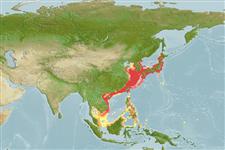Common names from other countries
Environment: milieu / climate zone / depth range / distribution range
Ekologi
marina bottenlevande; havsvandrande (Ref. 51243); djupintervall 10 - 200 m (Ref. 11230). Subtropical; 62°N - 1°N, 99°E - 163°E (Ref. 54698)
Western Pacific: Japan, Sakhalin, Kuril Islands, Korean Peninsula to the South China Sea.
Length at first maturity / Size / Vikt / Age
Maturity: Lm ?, range 40 - ? cm
Max length : 103 cm TL hane/ej könsbestämd; (Ref. 40637); publicerad maxvikt: 9.1 kg (Ref. 40637)
Taggstrålar i ryggfenan (totalt) : 0; Mjukstrålar i ryggfenan (totalt) : 77 - 81; Taggstrålar i analfenan: 0; Mjukstrålar i analfenan: 59 - 61; Ryggkotor: 38.
Most highly prized of the Japanese flounders.
Distinct pairing (Ref. 205).
Masuda, H., K. Amaoka, C. Araga, T. Uyeno and T. Yoshino, 1984. The fishes of the Japanese Archipelago. Vol. 1. Tokai University Press, Tokyo, Japan. 437 p. (text). (Ref. 559)
IUCN Red List Status (Ref. 130435)
CITES (Ref. 128078)
Not Evaluated
Threat to humans
Harmless
Human uses
Fiskeri: kommersiellt viktig; Vattenbruk: kommersiell
Verktyg
Special reports
Download XML
Internet-källor
Estimates based on models
Preferred temperature (Ref.
115969): 8.6 - 25, mean 18.8 (based on 241 cells).
Phylogenetic diversity index (Ref.
82804): PD
50 = 0.5000 [Uniqueness, from 0.5 = low to 2.0 = high].
Bayesian length-weight: a=0.00794 (0.00438 - 0.01441), b=3.07 (2.90 - 3.24), in cm Total Length, based on LWR estimates for this species & (Sub)family-body (Ref.
93245).
Trofisk nivå (Ref.
69278): 4.5 ±0.8 se; based on diet studies.
Resiliens (Ref.
120179): Mellan, lägsta populationsfördubblingstid 1,4-4,4 år (tm=3; Fec= 3 million).
Fishing Vulnerability (Ref.
59153): High vulnerability (60 of 100).
Climate Vulnerability (Ref.
125649): Moderate vulnerability (43 of 100).
